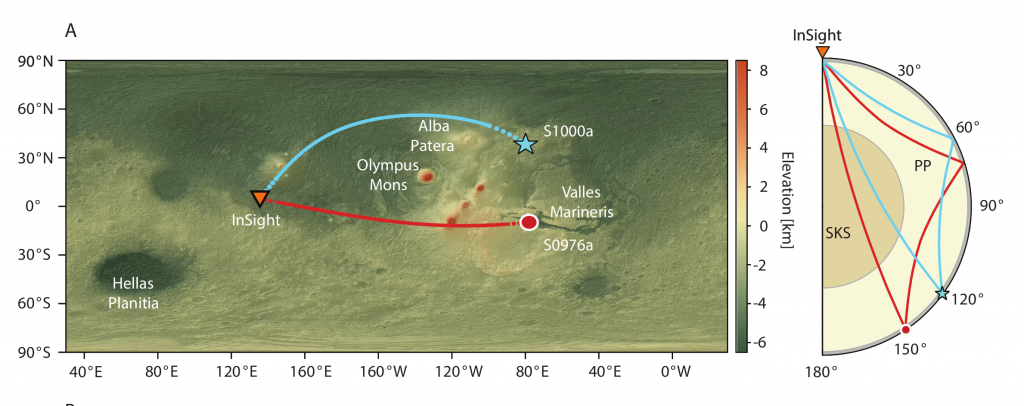The core-transiting seismic waves unveil the properties of the Martian core
Seismology has been used as a means of exploring the Earth’s interior for over a century. With the recent detection of Mars quakes by the seismometer of the InSight (Interior Exploration using Seismic Investigations, Geodesy and Heat Transport) mission, scientists can now probe the Martian deep interior.
For over a century, scientists have analyzed seismic waves that travel through the Earth’s layers to probe its deep structure and inform on the physical properties of its mantle and core. The core of Mars has been found to be at least partially liquid, as revealed by measuring tides and more recently, by detecting seismic waves reflected at the core-mantle boundary. New research published in the latest issue of the Proceedings of the National Academy of Sciences takes our knowledge about the core of the Red Planet to a new level. In 2021, two large seismic events whose waves traversed the core were detected by the InSight seismometer SEIS (Seismic Experiment for Interior Structure) and allowed for the first time to directly probe the elastic properties of the core. Among the co-authors of this paper is Attilio Rivoldini from the Royal Observatory of Belgium.
The path taken by seismic body waves, traveling from the focus to the point of observation, is influenced by the density and elastic properties of the material layers. These characteristics, in turn, depend on the composition of the materials themselves. When traveling through the layers, the waves reflect or refract at the interfaces where the material properties change. Two types of seismic body waves exist: Primary (P) and Secondary (S) waves. P waves are compressional waves, similar to acoustic waves, while S waves are shear waves that cannot propagate through liquid layers.
SEIS has detected two seismic events emanating from the antipodal hemisphere of the planet (see figure). The resulting waves, that traveled through the mantle as S waves and traversed the core as P waves have never been observed before. They are denoted as SKS waves. By analyzing relative travel times of SKS waves to other mantle waves (PP and SS) and using existing geophysical and geochemical information, the study improved on our knowledge about the size and density of the core and directly constrained, for the first time, its seismic velocity. Taken together, existing, and new results inform on the equation of state of the core and subsequently, allow to refine our understanding about the amount and relative proportions of the light elements inside the core. Knowledge of the latter has far-reaching implications for the formation and evolution of Mars and has bearing on the absence of a present-day inner core and the early cessation of a core generated magnetic field.
The Insight mission ended in December of last year. Additional analyses of the data collected through SEIS and RISE (Rotation and Interior Structure Experiment) is expected to provide further insights into the interior of Mars and enhance our comprehension of the planet.

Left: Location of the two farside seismic events detected by SEIS (‘S1000a’ event is an impact). The lines represent the paths projected on the surface. Right: Schematic of the PP and SKS paths followed by the two events in the layers of Mars. Figure from Irving et al. (2023).
Reference
Irving et al. (2023), First observations of core-transiting seismic phases on Mars, Proceedings of the National Academy of Sciences, Vol. 120, No. 18. https://www.pnas.org/doi/10.1073/pnas.2217090120
Read also
https://www.astro.oma.be/en/insight-landing-mars-on-the-verge-of-revealing-its-secrets/
https://www.astro.oma.be/en/planet-mars-first-results-of-the-insight-mission-published-in-nature-geoscience/
https://www.astro.oma.be/en/mars-interior-structure-revealed-by-insight-seismic-data/
